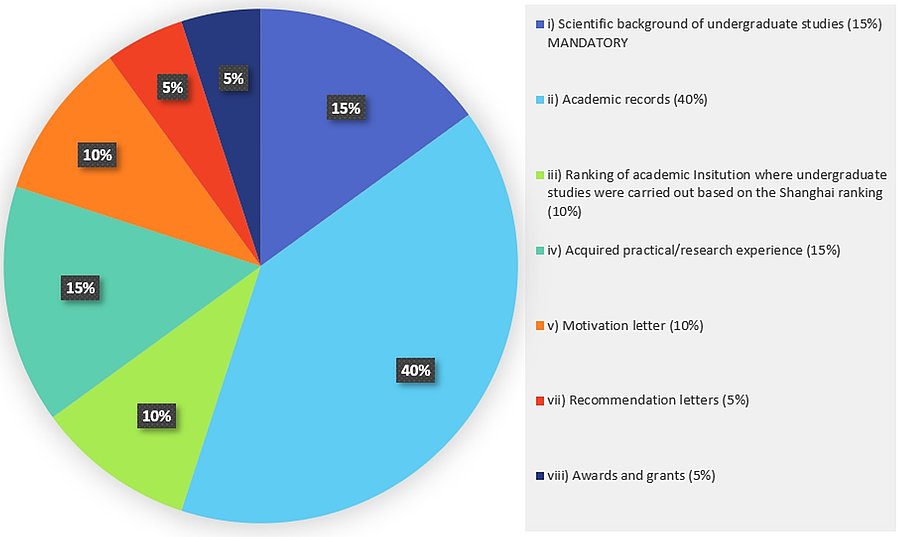sur bandeau ligne 2
Selection Procedure
Selection of applications for the BIOPHAM European Master
The selection of applications is coordinated by “the Selection and Examination” Board of the BIOPHAM Master including members of the four partner Universities (UNIPI, UPC, USK, ULILLE). Student application for admission in the BIOPHAM programme is entitled for students holding a Bachelor Degree in physics, chemistry, physics-chemistry, materials science or nanoscience. Applicants awarded with a Bachelor Degree in related fields such as pharmaceutical sciences or life sciences with excellent academic records can also be considered. However, applicants should provide in their application a convincing demonstration that they have a strong background in chemistry and/or physics.
A FOUR-STEP SELECTION PROCEDURE
Step 0: Administrative checking and validation
Following the closure of the call for applications, all applications are checked in order to remove incomplete applications (required information is missing or misfiled; compulsory document(s) not provided) and incorrectly completed applications (documents or information provided not in English, illegible documents, unreadable files, etc.).
All incomplete or incorrectly completed applications are rejected at this initial step.
Step 1: Evaluation of the “i) Scientific background of undergraduate studies” criterion
“i) Scientific background of undergraduate studies” is a mandatory criterion.
This first criterion evaluates the eligibility of previous studies of the candidate and the degree of matching between “the initial training (undergraduate studies) of the applicant” and the “training provided by the BIOPHAM Master”. All submitted applications are independendly evaluated by three evaluators from three different partner Universities and marked on a scale from 1 (very poor) to 5 (outstanding). Each application is thus independently examined three times and thus receives three marks which are automatically averaged.
Since “i) Scientific background of undergraduate studies” is a mandatory criterion, only the applications which reach the threshold minimum score of 2.5 (on a [0-5] scale) for the average mark are kept at this stage in the continuation of the evaluation process. The applications which do not reach the threshold minimum score of 2.5 (on a [0-5] scale) for the average mark are directly rejected at this step.
Important note: it important to note that it is at step 1 that most applications of candidates without a first higher education Science degrees (bachelor) in physics, chemistry, physics-chemistry, materials science or nanoscience are rejected. This is why candidates awarded with a Bachelor degree in related fields such as pharmaceutical sciences or life sciences have to provide in the application procedure a clear and convincing demonstration that they have a strong background in chemistry and/or physics.
Step 2
Applications which have passed step 1 are then reviewed for the following selection criteria: ii) Academic records, iii) Shanghai ranking, iv) Acquired previous practical/research experience, v) Motivation letter, vi) Recommendation letters and vii) Awards and grants.
The applications are reviewed by a single evaluator to evaluate the “ii) Academic records” criterion. This criterion corresponds to the academic records of the applicants during its undergraduate’s studies. The GPA (grade point average) system is not used. Only academic records related to “scientific” courses are considered in this evaluation excluding language courses, cultural courses, … The Spanish system of conversion of grades is used[1] to automatically convert the marks obtained in the University of origin of the applicant into a common [0-5] scale. All converted marks are then averaged into a single mark on a common [0-5] scale.
The applications are reviewed by a single evaluator to evaluate the “iii) Shanghai ranking” criterion. It is based on the the ranking of the academic Institution where undergraduate studies of the candidate were carried out based on the Shanghai ranking. A mark on a [0-5] scale is automatically calculated based on a database developped at the University of Lille.
For the remaining criteria: iv) Acquired previous practical/research experience, v) Motivation letter, vi) Recommendation letters and vii) Awards and grants, applications are independendly evaluated by two evaluators from two different partner Universities and marked on a scale from 1 (very poor) to 5 (outstanding). Each application is thus examined two times and thus receives two marks which are automatically averaged.
All marks obtained by the applications obtained at step 1 and 2.i.e. i) Scientific background of undergraduate studies” (15%), ii) Academic records (40%), iii) Shanghai ranking (10%), iv) Acquired previous practical/research experience (15%), v) Motivation letter (10%), vi) Recommendation letters (5%) and vii) Awards and grants (5%) are averaged and weighted to get the final mark of the application. This average is used for the ranking of the applications.
Step 3 : Short-list, interviews and final selection
Based the ranking obtained at step 2, a short list of about 60 applications is made. The short-listed candidates are contacted for an interview organized as a videoconference.
Following the interview, the final ranking of applicants is made by averaging the scores from the electronic applications (50%) with the interview performance (50%). The generated ranking is used by the Selection and Examination Board to establish a selection of approximately 40 applicants. Two final lists are established: i) a list of selected students for the award of an Erasmus+ scholarship (about 20 students) and ii) a reserve list including all the remaining selected students (about 20 students).
https://www.educacionyfp.gob.es/dam/jcr:269e23ac-8940-42b6-b455-35df18c753a3/anexo-i-escalas.pdf

